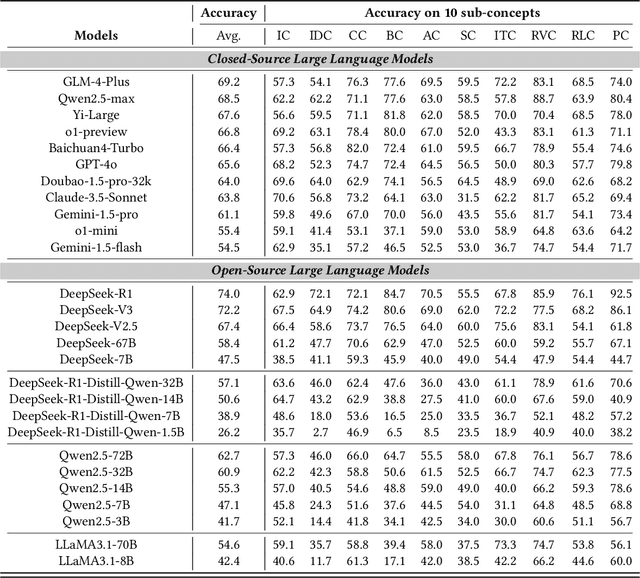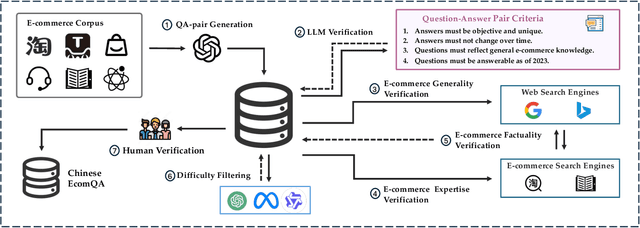Yujin Yuan
RecGPT Technical Report
Jul 30, 2025Abstract:Recommender systems are among the most impactful applications of artificial intelligence, serving as critical infrastructure connecting users, merchants, and platforms. However, most current industrial systems remain heavily reliant on historical co-occurrence patterns and log-fitting objectives, i.e., optimizing for past user interactions without explicitly modeling user intent. This log-fitting approach often leads to overfitting to narrow historical preferences, failing to capture users' evolving and latent interests. As a result, it reinforces filter bubbles and long-tail phenomena, ultimately harming user experience and threatening the sustainability of the whole recommendation ecosystem. To address these challenges, we rethink the overall design paradigm of recommender systems and propose RecGPT, a next-generation framework that places user intent at the center of the recommendation pipeline. By integrating large language models (LLMs) into key stages of user interest mining, item retrieval, and explanation generation, RecGPT transforms log-fitting recommendation into an intent-centric process. To effectively align general-purpose LLMs to the above domain-specific recommendation tasks at scale, RecGPT incorporates a multi-stage training paradigm, which integrates reasoning-enhanced pre-alignment and self-training evolution, guided by a Human-LLM cooperative judge system. Currently, RecGPT has been fully deployed on the Taobao App. Online experiments demonstrate that RecGPT achieves consistent performance gains across stakeholders: users benefit from increased content diversity and satisfaction, merchants and the platform gain greater exposure and conversions. These comprehensive improvement results across all stakeholders validates that LLM-driven, intent-centric design can foster a more sustainable and mutually beneficial recommendation ecosystem.
Reinforcement Learning Optimization for Large-Scale Learning: An Efficient and User-Friendly Scaling Library
Jun 06, 2025Abstract:We introduce ROLL, an efficient, scalable, and user-friendly library designed for Reinforcement Learning Optimization for Large-scale Learning. ROLL caters to three primary user groups: tech pioneers aiming for cost-effective, fault-tolerant large-scale training, developers requiring flexible control over training workflows, and researchers seeking agile experimentation. ROLL is built upon several key modules to serve these user groups effectively. First, a single-controller architecture combined with an abstraction of the parallel worker simplifies the development of the training pipeline. Second, the parallel strategy and data transfer modules enable efficient and scalable training. Third, the rollout scheduler offers fine-grained management of each sample's lifecycle during the rollout stage. Fourth, the environment worker and reward worker support rapid and flexible experimentation with agentic RL algorithms and reward designs. Finally, AutoDeviceMapping allows users to assign resources to different models flexibly across various stages.
ECKGBench: Benchmarking Large Language Models in E-commerce Leveraging Knowledge Graph
Mar 20, 2025Abstract:Large language models (LLMs) have demonstrated their capabilities across various NLP tasks. Their potential in e-commerce is also substantial, evidenced by practical implementations such as platform search, personalized recommendations, and customer service. One primary concern associated with LLMs is their factuality (e.g., hallucination), which is urgent in e-commerce due to its significant impact on user experience and revenue. Despite some methods proposed to evaluate LLMs' factuality, issues such as lack of reliability, high consumption, and lack of domain expertise leave a gap between effective assessment in e-commerce. To bridge the evaluation gap, we propose ECKGBench, a dataset specifically designed to evaluate the capacities of LLMs in e-commerce knowledge. Specifically, we adopt a standardized workflow to automatically generate questions based on a large-scale knowledge graph, guaranteeing sufficient reliability. We employ the simple question-answering paradigm, substantially improving the evaluation efficiency by the least input and output tokens. Furthermore, we inject abundant e-commerce expertise in each evaluation stage, including human annotation, prompt design, negative sampling, and verification. Besides, we explore the LLMs' knowledge boundaries in e-commerce from a novel perspective. Through comprehensive evaluations of several advanced LLMs on ECKGBench, we provide meticulous analysis and insights into leveraging LLMs for e-commerce.
ChineseEcomQA: A Scalable E-commerce Concept Evaluation Benchmark for Large Language Models
Feb 27, 2025



Abstract:With the increasing use of Large Language Models (LLMs) in fields such as e-commerce, domain-specific concept evaluation benchmarks are crucial for assessing their domain capabilities. Existing LLMs may generate factually incorrect information within the complex e-commerce applications. Therefore, it is necessary to build an e-commerce concept benchmark. Existing benchmarks encounter two primary challenges: (1) handle the heterogeneous and diverse nature of tasks, (2) distinguish between generality and specificity within the e-commerce field. To address these problems, we propose \textbf{ChineseEcomQA}, a scalable question-answering benchmark focused on fundamental e-commerce concepts. ChineseEcomQA is built on three core characteristics: \textbf{Focus on Fundamental Concept}, \textbf{E-commerce Generality} and \textbf{E-commerce Expertise}. Fundamental concepts are designed to be applicable across a diverse array of e-commerce tasks, thus addressing the challenge of heterogeneity and diversity. Additionally, by carefully balancing generality and specificity, ChineseEcomQA effectively differentiates between broad e-commerce concepts, allowing for precise validation of domain capabilities. We achieve this through a scalable benchmark construction process that combines LLM validation, Retrieval-Augmented Generation (RAG) validation, and rigorous manual annotation. Based on ChineseEcomQA, we conduct extensive evaluations on mainstream LLMs and provide some valuable insights. We hope that ChineseEcomQA could guide future domain-specific evaluations, and facilitate broader LLM adoption in e-commerce applications.
UQABench: Evaluating User Embedding for Prompting LLMs in Personalized Question Answering
Feb 26, 2025Abstract:Large language models (LLMs) achieve remarkable success in natural language processing (NLP). In practical scenarios like recommendations, as users increasingly seek personalized experiences, it becomes crucial to incorporate user interaction history into the context of LLMs to enhance personalization. However, from a practical utility perspective, user interactions' extensive length and noise present challenges when used directly as text prompts. A promising solution is to compress and distill interactions into compact embeddings, serving as soft prompts to assist LLMs in generating personalized responses. Although this approach brings efficiency, a critical concern emerges: Can user embeddings adequately capture valuable information and prompt LLMs? To address this concern, we propose \name, a benchmark designed to evaluate the effectiveness of user embeddings in prompting LLMs for personalization. We establish a fair and standardized evaluation process, encompassing pre-training, fine-tuning, and evaluation stages. To thoroughly evaluate user embeddings, we design three dimensions of tasks: sequence understanding, action prediction, and interest perception. These evaluation tasks cover the industry's demands in traditional recommendation tasks, such as improving prediction accuracy, and its aspirations for LLM-based methods, such as accurately understanding user interests and enhancing the user experience. We conduct extensive experiments on various state-of-the-art methods for modeling user embeddings. Additionally, we reveal the scaling laws of leveraging user embeddings to prompt LLMs. The benchmark is available online.
Unlocking Scaling Law in Industrial Recommendation Systems with a Three-step Paradigm based Large User Model
Feb 12, 2025Abstract:Recent advancements in autoregressive Large Language Models (LLMs) have achieved significant milestones, largely attributed to their scalability, often referred to as the "scaling law". Inspired by these achievements, there has been a growing interest in adapting LLMs for Recommendation Systems (RecSys) by reformulating RecSys tasks into generative problems. However, these End-to-End Generative Recommendation (E2E-GR) methods tend to prioritize idealized goals, often at the expense of the practical advantages offered by traditional Deep Learning based Recommendation Models (DLRMs) in terms of in features, architecture, and practices. This disparity between idealized goals and practical needs introduces several challenges and limitations, locking the scaling law in industrial RecSys. In this paper, we introduce a large user model (LUM) that addresses these limitations through a three-step paradigm, designed to meet the stringent requirements of industrial settings while unlocking the potential for scalable recommendations. Our extensive experimental evaluations demonstrate that LUM outperforms both state-of-the-art DLRMs and E2E-GR approaches. Notably, LUM exhibits excellent scalability, with performance improvements observed as the model scales up to 7 billion parameters. Additionally, we have successfully deployed LUM in an industrial application, where it achieved significant gains in an A/B test, further validating its effectiveness and practicality.
Cross-relation Cross-bag Attention for Distantly-supervised Relation Extraction
Dec 27, 2018



Abstract:Distant supervision leverages knowledge bases to automatically label instances, thus allowing us to train relation extractor without human annotations. However, the generated training data typically contain massive noise, and may result in poor performances with the vanilla supervised learning. In this paper, we propose to conduct multi-instance learning with a novel Cross-relation Cross-bag Selective Attention (C$^2$SA), which leads to noise-robust training for distant supervised relation extractor. Specifically, we employ the sentence-level selective attention to reduce the effect of noisy or mismatched sentences, while the correlation among relations were captured to improve the quality of attention weights. Moreover, instead of treating all entity-pairs equally, we try to pay more attention to entity-pairs with a higher quality. Similarly, we adopt the selective attention mechanism to achieve this goal. Experiments with two types of relation extractor demonstrate the superiority of the proposed approach over the state-of-the-art, while further ablation studies verify our intuitions and demonstrate the effectiveness of our proposed two techniques.
 Add to Chrome
Add to Chrome Add to Firefox
Add to Firefox Add to Edge
Add to Edge